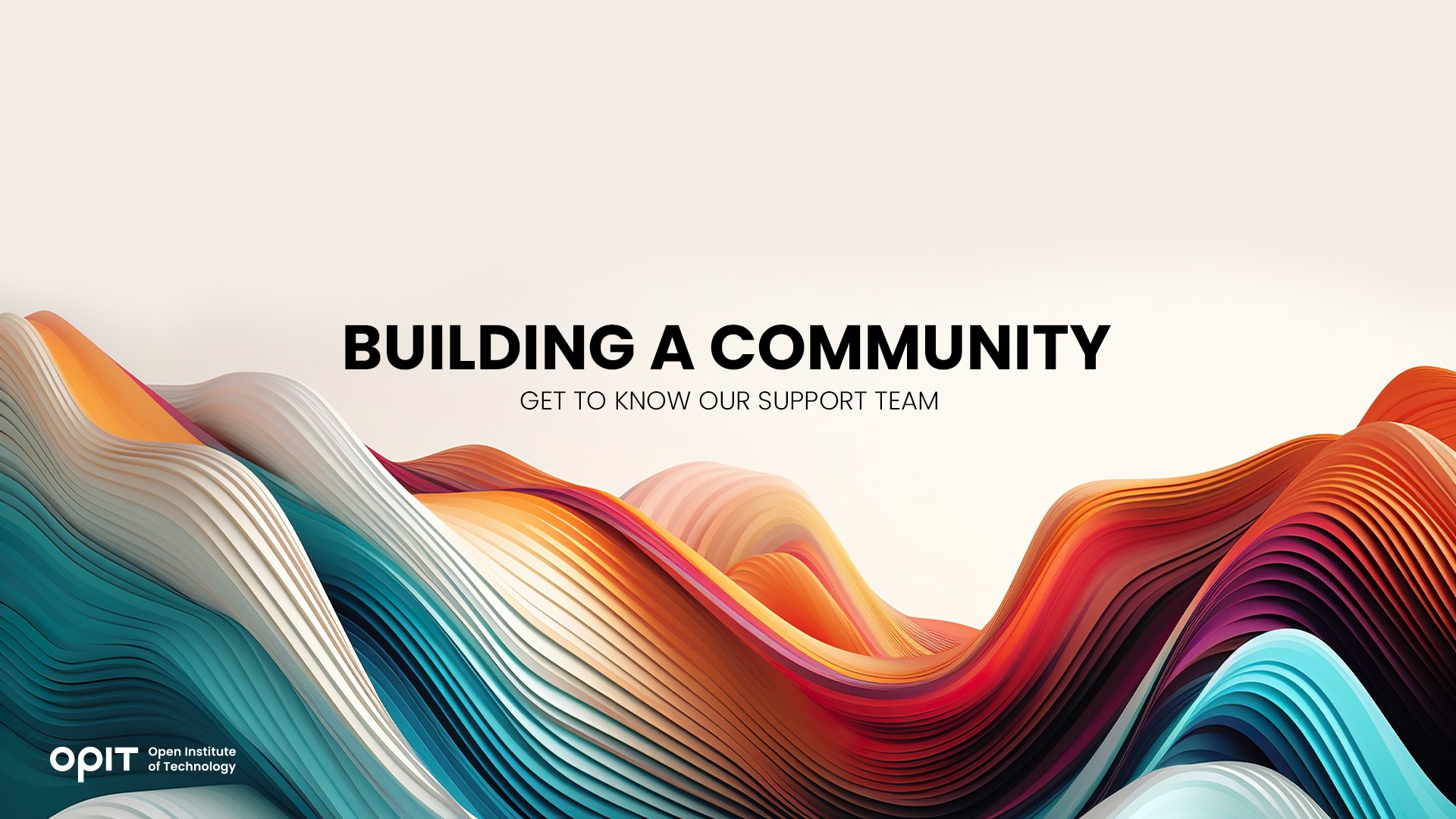

Although convenient, online studying can also feel isolating. After all, you’re all alone in front of a screen, probably missing the camaraderie and face-to-face interactions of a physical classroom.
That’s why our team at the Open Institute of Technology set out to change the typical online education experience, breaking down all the virtual barriers before them. The goal is clear – OPIT students are never to feel alone during any step of their academic journey. And this goal wasn’t only met but surpassed rather spectacularly (if we do say so ourselves).
Are you interested to know how our team pulled it off? Great! At OPIT, we love questions, as well as sharing success stories.
To answer this question thoroughly, we enlisted the help of Rosario Maccarrone, our Director and Head of Student Services, and Sara Ciabattoni, our Class Coordinator. They’ll break down OPIT’s impressive support system, which has effortlessly transformed students from over 40 countries worldwide into a close-knit community.
How Does OPIT Support Its Students?
When it comes to student support, one thing’s for sure – few (if any) remote learning programs offer such an intricate and well-thought-out web of support as OPIT does. This support starts before you even enroll in the Institute and often ends only after you’ve landed your dream job.
Admission Support
At OPIT, we have a dedicated admissions team that guides applicants every step of the way – from expressing interest in a specific course to becoming a student. This team has a simple goal – to ease your path into OPIT. So, don’t hesitate to ask any questions regarding the application process itself, program details, or course requirements.
Administrative Support
Let’s not sugarcoat it – starting a new program can be extremely chaotic. You might have trouble enrolling in courses, managing your schedule, and navigating all the complexities of a new academic environment. But don’t worry; it’s our administrative support team to the rescue! This team will help you breeze through all the administrative requirements, from applying for courses to getting certificates.
In this regard, we must also mention the lovely Sara, aka our class coordinator.
Class Coordinator
The class coordinator is here to help the OPIT students with their everyday needs and tasks. This might include questions about classes, deadlines, or interactions with other students and faculty members. Let’s put it this way – if you’re ever unsure who to reach out to, Sara is your go-to person.
As she puts it, “You can reach out to me, and I will guide you.” Take this as a blanket statement, whether you have a specific question or are simply struggling with time management or your studies.
Learning Support
At the end of the day, all OPIT students are here to learn. That’s why Rosario made it his mission to ensure top-notch learning support for each and every OPIT student.
Tutors
It’s perfectly natural to struggle with specific parts of your coursework, especially if you’re dealing with these concepts for the first time. That’s why there’s a dedicated team of tutors at your disposal at all times.
When we say “at all times,” we truly mean it! These tutors are available seven days a week, every day of the calendar year. You can reach them and ask for any lecture-related assistance you might need.
You’ll promptly receive an answer from these professionals who have strong backgrounds in computer science and tech. Most of our academic tutors have a PhD or are currently obtaining one, so you can rest assured you’re in good hands.
Professors
With classroom learning, posing a question to your professor is a breeze – you just raise your hand! In most online classrooms, however, this option doesn’t exist since classes are usually pre-recorded.
That’s why OPIT offers a live class once a week featuring a handy Q&A session. This session is the perfect opportunity to directly interact with professors in charge of different subjects, gather all the necessary information, or resolve any doubts. After all, some questions are quite complex and can only be answered by the experts.
And that’s precisely what our professors are. Some of them have taught in universities for their entire careers. Others have a long and impressive history in the industry, having worked at tech giants like Microsoft and Meta. Either way, our careful selection of professors is a guarantee that “what we say is what we do,” as Rosario puts it.
Continuous Assessment
Though this isn’t a team per se, the continuous assessment methodology employed by the OPIT faculty is a crucial element of support for our students.
This methodology is exactly what it sounds like – students are assessed continuously throughout the duration of their courses. There are many pedagogical benefits to this approach, but the two primary ones are as follows.
One, our students can advance their knowledge gradually, which allows them to retain and apply information more effectively. And two, it eliminates the stress of cramming for the big and scary final exam that often overwhelms the students. Sara emphasizes that this approach allows you to enter the job market with a well-rounded understanding of your field.
Career Support
Speaking of entering the job market, OPIT will lend you a helping hand in this regard as well. The goal of the career support team is to “help students shift from their academic journey into their professional journey [with ease],” as Sara puts it.
Career Advisors
Given that most OPIT programs equip you with skills for dozens of different career paths, you might struggle with choosing only one. That’s where our career advisors come into play.
As you approach the end of your academic journey, these advisors will work with you to assess your skills, capabilities, and qualities, helping you pinpoint the most suitable career path. Then, they’ll review your CV and coach you on presenting yourself to potential employers in the best possible way. They’ll even help you look for a job and present you with some tailored job listings.
Internship Opportunities
If you want to gather more practical experience before fully entering the professional arena, our career advisors can help you find tailored internship positions to suit your needs.
Practical Skills
There’s a reason the above section is so short. OPIT prides itself on its competence-based approach that lets students “learn by doing,” as Rosario puts it.
OPIT courses are pretty hands-on, with at least two assignments whose goal is to help you put your knowledge into practice. Rosario calls this “filling the gap between theoretical knowledge served by classical universities and applied knowledge that is more often than not given through boot camps or non-accredited courses.”
The goal of this approach is to ensure students can “hit the ground running” and “apply their knowledge from day one.” There’s no need to go through a lengthy training process or learn anything from scratch!
Communication Channels
Given that our mantra at OPIT is “You’re not alone,” it shouldn’t surprise you that we offer several ways to communicate with fellow students and faculty staff.
Canvas
Canvas, our learning platform, is a treasure trove of knowledge and valuable resources. However, it can also serve as a vibrant communication hub.
You see, Canvas offers an option to start (or join) discussions and ask questions regarding anything course-related. Sometimes, professors can even publish some interesting and thought-provoking prompts that go beyond the traditional course material.
In addition, during some live classes (hosted on Zoom and available in Canvas), students are divided into smaller groups and put into breakout rooms. This typically gives them 10 to 15 minutes to work together and start a little discussion or debate. Sara says that she sees “a lot of interaction there,” as she has access to all courses and can review the exchanged messages.
Slack
While Canvas is the ultimate learning platform, it’s slightly too formal for student interactions. That’s why we also provide our students with access to a Slack channel for their classes and each of their courses. Here, students can share “whatever they see fit,” as Rosario puts it.
Moreover, Slack is a valuable tool in the professional context (widely used and integrated into workflows in many companies) – by being able to know and use the tool, students get closer to their job market.
Other Communication Channels
OPIT students are free to use whatever communication channels they want. It’s only natural for them to want to communicate in an environment that’s entirely under their control, as opposed to faculty-controlled Canvas and Slack.
We see no problem with this. In fact, it’s quite the opposite! As Sara explains it perfectly, “We’re really proud because we’re building a community.”
For now, our students prefer communicating via WhatsApp groups and Discord servers, which they use to share their experiences, feelings, and problems. Rosario says that it’s easy to tell what some of these discussions are, as they often spill over in some of the requests the Institute receives in terms of administration and term organization. Of course, we’re always open to feedback and do our best to accommodate the preferences of our students, especially when they’re so wonderfully united.
At OPIT, You’re Never Alone
And there you have it – the complete support system devised to ensure that every OPIT student feels connected, supported, and empowered throughout their academic journey. Apply for one of our highly acclaimed programs today and experience this unparalleled support firsthand.
Have questions?
Visit our FAQ page or get in touch with us!
Write us at +39 335 576 0263
Get in touch at hello@opit.com
Talk to one of our Study Advisors
We are international
We can speak in:




